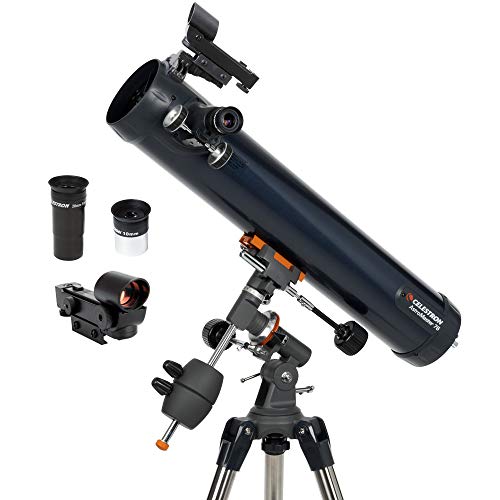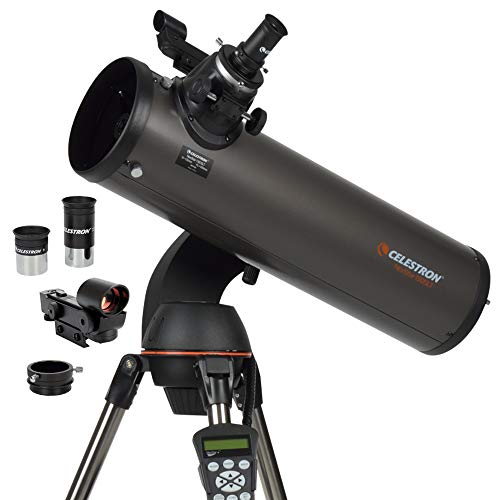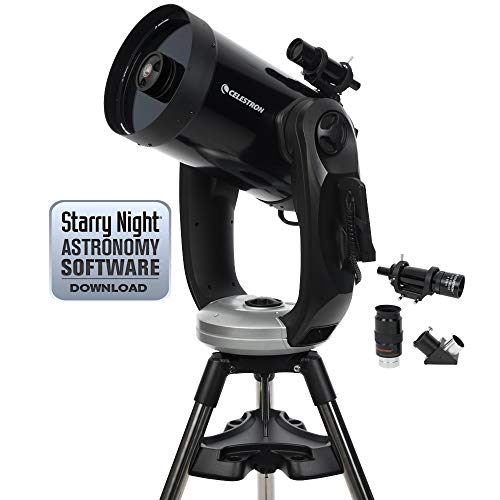Orion vs Celestron Telescopes: Which is Better?
Last Updated on
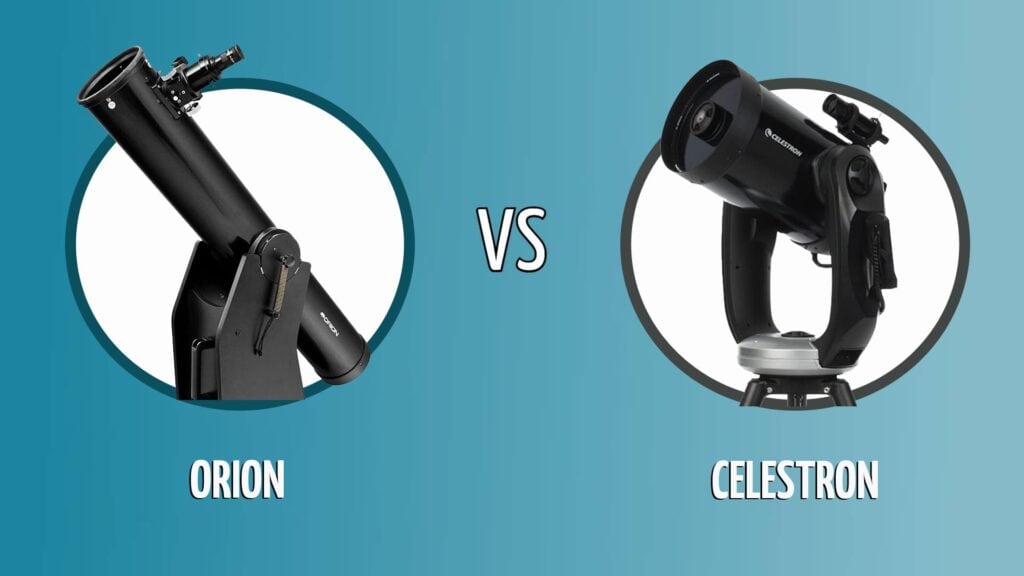
In the world of astronomy, two brands are recognized as the standard, setting the bar for telescopes worldwide. A simple google search for telescopes will return many results from these two companies; Orion and Celestron.
Both are considered to be top-of-the-line companies that make high-quality telescopes and accessories. Whether you’re a total beginner looking for your first telescope or you’re a seasoned pro looking for a high-tech tool to expand your astronomy kit, you can find what you’re looking for with either brand.
So, which brand should you choose? What differences can you expect between them? To help you understand the differences between these two well-respected manufacturers, we’re going to compare these two brands and their top offerings. Hopefully, you’ll have the answers you seek by the end of this article.
Orion vs Celestron: At a Glance
| Orion | Celestron | |
| Established | 1975 | 1964 |
| Manufactured in | China | Taiwan |
| Beginner-friendly | Yes | Yes |
| Price | $65 – $9,500 | $50 – $8,700 |
| Warranty | 1-year limited | 2 years to limited lifetime |
About Orion
Covering all types of telescopes, binoculars, and accessories, Orion has been producing high-quality astronomy equipment since 1975. They’re now an employee-owned company with a 100% satisfaction guarantee that shows their commitment to their patrons.
From beginner’s equipment to computerized telescopes for astronomy pros, Orion has equipment for every skill level. Their telescopes are protected by a one-year limited warranty and all of their products include a 30-day money-back guarantee so you can rest easy when you purchase from Orion.
What Orion Has to Offer
When you look through Orion’s catalog, you can easily be overwhelmed by the sheer number of products they offer. But this also means you get incredible selection. Telescopes, binoculars, tripods, cases, and more are all available.
Orion carries telescopes for every price range and skill level. You can get started for less than $100 or you can spend several thousand for a top-tier telescope with every bell and whistle. They carry Cassegrain telescopes, Dobsonian telescopes, refractor and reflector telescopes, and even telescopes for kids to start building a love for the stars early.
Top Orion Models
If you’re just getting into astronomy and you’re looking for the basic tools to get started, Orion has some of the most affordable offerings available. For under $50, you can get their Infinity series 50-millimeter refracting telescope with a precision Alt-azimuth mount, three eyepieces with different levels of magnification, and an aluminum tripod for mounting.
For a bit more, you can step up to their Adventure Scope or StarPro AZ lines. Here you can move up from a 50-millimeter refractor to a 70-millimeter refractor with a 700-millimeter focal length and slow-motion control cables.
Beginner
If you’re looking for a budget-priced beginner telescope that’s still got the features you need to have fun observing outer space, then you can’t go wrong with Orion. Their Observer II Altazimuth Refractor Telescope is well under $100 making it very affordable to get started in astronomy. In fact, Orion offers several telescopes and packages around the $100 price point to give you plenty of options for getting started.
StarMax 90mm TableTop Maksutov-Cassegrain Telescope

Compact but plenty powerful, the StarMax Tabletop Telescope brings portability to stargazing. At just 6.5 pounds and 20 inches tall, this device is small enough to bring with you on trips where the night sky will be more visible, like when you’re camping. Unfortunately, no carrying case is included to keep it safe during travel.
But just because it’s small doesn’t mean you’ll be missing out on anything. This telescope includes two eyepieces to ensure that you’ll be able to get the full picture. One eyepiece offers 50x magnification, the other provides an impressive 125x. This will allow you to see Jupiter and all four moons if conditions permit.
The 90-millimeter aperture allows viewing of brighter deep space objects such as nebulas, galaxies, and the surface of the moon. But it’s not going to be quite as bright as you might see with a much larger telescope. Still, it’s an affordable way to get started with astronomy and will allow you to clearly see many heavenly bodies.
- The tabletop design doesn’t take up much space
- Great for taking on trips
- Includes two eyepieces for 50x and 125x magnification
- Wind won’t affect the scope because of its smaller size
- No carrying case for transporting it
Intermediate
If you’ve graduated past the beginning stages of astronomy and you need a more serious tool for continued astronomical study, Orion still has you covered. Starting at about $300 and ranging up to around $600, their intermediate lineup offers improved features and functions over their beginner-friendly offerings. In this range, some of the models are even completely computerized, offering one-touch navigation that will point your telescope to the exact right spot with the touch of a button.
StarSeeker IV 102mm GoTo Mak-Cass Telescope

With computerized motion and a massive GoTo database of more than 42,000 celestial objects, the StarSeeker IV 102mm GOTO Mak-Cass Telescope can help you take your astronomy to the next level. You’ll just need to properly align the telescope, then you’ve got one-touch capabilities at your fingertips.
Input the object you want to see and the telescope will automatically focus on the right spot for you to view. Even better, you’ll be able to manually aim the telescope without losing your alignment! But the backlash or lag can be substantial, making it difficult to manually track objects.
Thanks to the extended focal length of 1300 millimeters and the f/12.7 aperture, you’ll be able to see razor-sharp detail in far-off planets and other space objects. Once you locate an object, you can relax and let the StarSeeker track it while you view. No more losing your target as the skies change during the night.
Included with this telescope are two 60-degree eyepieces that offer 57x and 130x magnification respectively. You’ll also get the 90-degree diagonal for more comfortable viewing, plus the GoTo hand controller for easily inputting coordinates to electronically control the telescope.
- Automatically locates 42,000 celestial objects
- Can automatically track heavenly bodies
- You can manually aim without losing alignment
- Includes two different 60-degree eyepieces with different magnification
- Can have a substantial backlash
Advanced
When it comes to high-end, professional-level telescopes, Orion has quite a few offerings. Ranging in price from $1,000 to $9,500, they’ve got offerings for every budget. These are top-of-the-line telescopes with incredible features. Some include cameras and mounts, many are computer-controlled, all will allow you to see the sky as you’ve never seen it before.
Orion 10135 SkyQuest XT10g Computerized GOTO Dobsonian Telescope
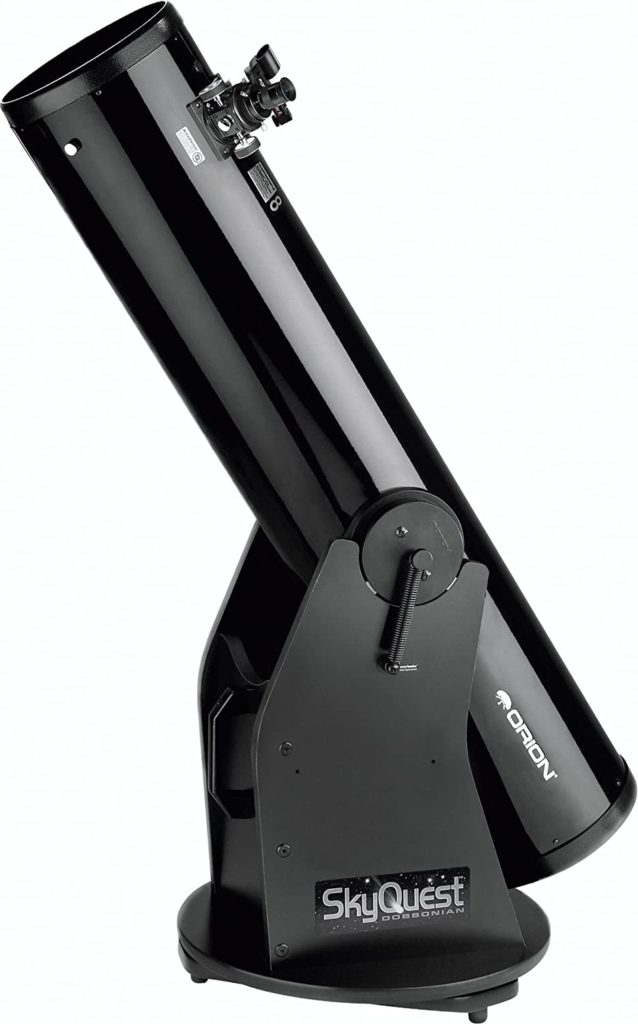
Completely motorized and electronically controlled, the Orion SkyQuest XT10g Computerized GoTo Dobsonian Telescope will help you discover the heavens as you’ve never imagined. It’s got a massive 10-inch aperture reflector that gathers tons of light, enabling you to see great detail in celestial bodies that are many lightyears away.
With GoTo technology, you can easily locate any of 42,000 charted heavenly objects with the press of a button. Then, the XT10g will automatically track your subject so all you have to do is observe. And with a maximum usable magnification of 300x, you’ll be able to see detail in celestial objects that are far past the range of lower-end telescopes.
One of the biggest draws to this device is the computer-controlled GoTo software. But you’ll need a 12V power supply if you want to use any of the motorized features. You’ll also need to make sure it’s properly aligned to start with. Once you do, you’ll be able to manually adjust the telescope as desired and it will still retain its alignment so you can return with the push of a button.
- Large 10” aperture reflector gathers lots of light
- All computerized parts are pre-installed
- Automatically locates and tracks heavenly bodies
- Highest useful magnification of 300x
- Requires 12V power supply for motorized operation
About Celestron
First established in 1964 in Torrance, California, Celestron became a success because its founder Tom Johnson found an inexpensive way to mass-produce corrector plates. This allowed Celestron to produce a line of more affordable Schmidt-Cassegrain telescopes.
But it wasn’t until 1970 that Celestron created the C8 telescope that we know today, which became one of the highest-selling amateur telescopes of all time. It was also the first one small enough to fit inside of a car and made astronomy affordable for the masses. A very similar C8 is still in production today making it the longest-running mass-produced telescope ever.
Amateur telescopes aren’t all that Celestron makes, though. They’re known for making some of the best telescopes in the world, and even offer professional models that cost over $8,000. Every telescope they sell comes with a two-year warranty from their cheapest telescope that’s under $50 to their most expensive professional devices.
What Celestron Has to Offer
Starting at a mere $50, Celestron has models for every level of the budding astronomer. They have many models designed to get you started in astronomy and allow your love for it to grow. But they also have some telescopes that are near $10k in price, such as the CGX-L telescope.
No matter what type of telescope you end up choosing, Celestron stands behind them all with a two-year warranty. Even better, they provide a limited lifetime warranty on the basic optical system for the lifetime of the product under the original owner.
With one of the best warranties in the industry backing up their products and many diverse telescopes to choose from at all levels, it’s easy to see why so many people trust Celestron for their astronomy needs.
Top Celestron Models
Beginner
If you’re looking for a solid place to get started with astronomy, Celestron’s beginner lineup is packed full of inexpensive options so you can start finding and following your favorite heavenly bodies right away. In fact, there are more than a dozen telescopes in the Celestron lineup that you can get for under $100.
The PowerSeeker models start below $50 and come in a variety of builds. You also have FirstScope models and Travel Scope portable telescopes available in the same price range, giving you plenty of choices for picking the right telescope to get started with.
AstroMaster 76EQ Newtonian Telescope
The AstroMaster 76EQ is an affordably-priced entry-level telescope that is perfect for beginning astronomers to get started with. It’s got high-quality optics that are fully coated and produce a clear and crisp image. This is an ideal telescope for observing the moon, stars, and even other planets in our solar system. But you’ll probably want to get an eyepiece with more magnification for getting a more detailed view.
Still, this one comes with two eyepieces, 10-millimeter and 20-millimeter, to give you some options with how you’re observing. You’ll also get an adjustable-height tripod to set the telescope on. It’s surprisingly stable with 1.25-inch thick legs made of steel tubing.
This telescope features two slow-motion control knobs to allow precise control. You can use them to make precision adjustments to find and follow celestial objects. And like with all of Celestron’s products, this telescope comes with a two-year warranty so you’ll be able to observe the skies for years.
- Affordably priced
- Adjustable-height tripod included
- Fully coated optics
- Includes 20mm and 10mm eyepieces
- Needs more magnification for detailed observations
Intermediate
Once you’ve graduated past entry-level telescopes and you are ready for something a bit closer to professional quality, Celestron has many intermediate-level offerings that will open up new doors for you and expand your reach into the universe.
The StarSense series begins around $400 and offers smartphone control. The NexStar lineup also starts around the same price and provides fully computerized telescopes that can find almost any object in space automatically once you input the coordinates.
This can make it considerably easier and far faster to locate and follow your favorite heavenly bodies, especially since the computer can follow them for you while you sit back and observe.
NexStar 130SLT Computerized Telescope
How many celestial objects can you find and name in the sky? Certainly not as many as the 40,000 objects you can set your Celestron NexStar 130SLT Computerized Telescope to find. All you have to do is push a few buttons to tell it which objects to locate, then, let the computer do the work. In a few seconds, your telescope will be pointed directly at the objects you wish to observe. Even better, the telescope will continue to follow them as the earth rotates and the sky seems to move. All you have to do is observe!
This telescope is designed to let you see far out into space, observing the planets in our solar system in greater detail than you’ve likely ever seen before. With a 130-millimeter aperture, the NexStar 130SLT lets in enough light to let you see past the reaches of our solar system, though you’d see even more if you upgraded the eyepieces.
With this powerful telescope, you can see the rings around Saturn or the cloud bands that surround Jupiter. And thanks to the SkyAlign technology this telescope is equipped with, you will be able to get it aligned quickly with no hassle.
- Fully computerized to find over 40,000 celestial objects
- SkyAlign allows for quick setup and alignment
- 130mm aperture lets in plenty of light
- Needs better eyepieces to make full use of the powerful telescope
Advanced
If you’ve been studying the celestial world for years and you’re ready to move on to the top-tier telescopes that can view the farthest reaches of space, then the most advanced telescopes in Celestron’s lineup are going to suit you well. These devices start at about $2,000 and go up from there, reaching prices over $8,000.
For the price, you’ll get a lot of telescope. They’re all computer-controlled, allowing you to find any object in space with the touch of a few buttons. More importantly, these telescopes are ultra-powerful. Some sport rare-earth glass lenses, all of them have lenses free of coma and field curvature. No matter which one you choose, you’ll be able to see space with brand new eyes.
CPC 1100 StarBright XLT GPS Schmidt-Cassegrain 2800mm Telescope
If you want a powerful telescope with top-notch functionality and you’re not afraid of the high sticker price, then the Celestron CPC 1100 StarBright telescope is a great choice. This 11-inch Schmidt-Cassegrain telescope is equipped with Star Bright XLT optical coatings that allow for maximum light intake, giving you the brightest and most detailed view possible.
This telescope comes with a heavy-duty tripod to mount it on. Two-inch steel legs will hold the telescope steady and a fully computerized dual fork Azimuth mount makes it easy to maneuver the telescope however you see fit. Plus, the internal GPS on the StarBright means that it can locate nearly any celestial object with the push of a few buttons.
You’ll get a handy remote control with this telescope as well. This makes it possible to view important information or make adjustments while you’re viewing without having to step away or break your concentration.
- Fully computerized dual fork Azimuth mount
- Includes heavy-duty tripod with 2” steel legs
- Remote hand controller lets you make adjustments while viewing
- Internal GPS can locate 40,000 different celestial objects
- Weighs 92 pounds, you’re not taking it anywhere
Conclusion
When it comes to telescopes, two prestigious brands are known to make the best; Celestron and Orion. Celestron is known for their popular C8 telescope, the longest selling mass-produced telescope of all time. They make excellent tools for astronomy and offer a two-year warranty on all their products.
Orion also makes high-quality telescopes, from beginner models to professional-level tools. They only offer a one-year warranty on their products, but they’ve got a full line of Cassegrain, Dobsonian, and reflector telescopes, plus more.
Either brand is a great choice and you’ll be well served by a telescope from either well-respected company.
You might also be interested in: How to Collimate Your Telescope: 7 Easy Steps
About the Author Robert Sparks
Robert’s obsession with all things optical started early in life, when his optician father would bring home prototypes for Robert to play with. Nowadays, Robert is dedicated to helping others find the right optics for their needs. His hobbies include astronomy, astrophysics, and model building. Originally from Newark, NJ, he resides in Santa Fe, New Mexico, where the nighttime skies are filled with glittering stars.
Related Articles:
How to Clean a Refractor Telescope: Step-by-Step Guide
How to Clean a Telescope Eyepiece: Step-by-Step Guide
How to Clean a Rifle Scope: 8 Expert Tips
Monocular vs Telescope: Differences Explained (With Pictures)
What Is a Monocular Used For? 8 Common Functions
How to Clean a Telescope Mirror: 8 Expert Tips
Brightfield vs Phase Contrast Microscopy: The Differences Explained
SkyCamHD Drone Review: Pros, Cons, FAQ, & Verdict

